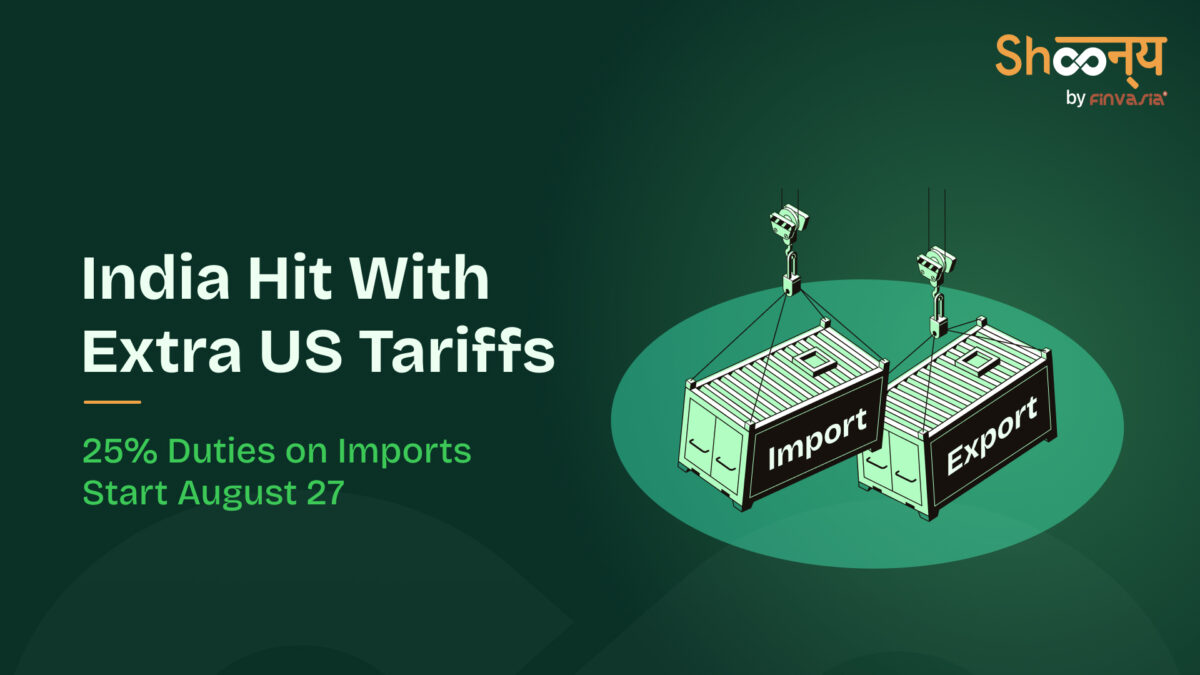Extra 25% US Tariff on India Exports: What It Means for You

The trade tussle between India and the United States has taken a sharp turn. The new 25% US tariff on India is set to take effect from August 27, 2025. Washington announces this as part of its broader strategy against countries maintaining close economic ties with Russia.
For India, the sudden tariff hike could mean tougher days ahead for exporters. This is for agriculture, dairy, textiles, and small businesses that depend heavily on the US market. While New Delhi has called the action “unjustified”. The government has assured that it will take decisive steps to protect the interests of traders, farmers, and entrepreneurs.
However, tariffs can shake up sector performance, market sentiment, and even currency movement. Understanding what this change means for Indian businesses and how it could impact portfolios will be key in the coming weeks.
Key Highlights of the US Tariff Notice
- The extra 25% tariff on Indian imports will come into effect from August 27, 2025, at 12:01 a.m. EDT.
- Washington has linked the move to its wider strategy of countering Russian influence.
- The Indian government is assessing the impact, with PM Modi assuring protection for small businesses, farmers, and entrepreneurs.
- This step follows earlier tariff hikes by the US, further straining trade relations between New Delhi and Washington.
Impact Analysis of the Tariff on Indian Imports
Here’s a US-India trade deal sector-wise impact analysis:
1. Market Impact
The announcement of higher tariffs is likely to create short-term volatility in Indian equity markets. Export-oriented companies may see selling pressure.
On the other hand, defensive sectors like FMCG and utilities could attract safer inflows. The rupee may also face depreciation risks against the US dollar due to weaker export earnings.
2. Sectoral Impact
- Agriculture & Dairy: The US has long pushed for greater access to India’s farm and dairy markets. Higher tariffs could hurt Indian producers exporting to the US.
- Textiles & Apparel: This sector is likely to face pricing disadvantages against competitors like Vietnam and Bangladesh.
- MSMEs: Smaller exporters, especially from textiles, leather, and handicrafts, could be disproportionately affected as margins shrink.
- IT & Services: Minimal direct tariff impact, but broader trade tensions could affect US client sentiment.
3. FII vs DII Flows
FIIs may turn cautious, pulling back from export-reliant sectors. However, DII, especially mutual funds powered by SIP flows, can provide some stability by absorbing the selling pressure.
Read more about FII vs DII inflows
4. Retail Investors & Traders
For investors, it signals a need to be selective. Export-heavy stocks may face struggles, while domestic demand-driven companies may remain resilient. Traders should expect higher intraday volatility around tariff implementation dates and related announcements.
What This Means for Traders & Investors
Here’s what you need to keep in mind before trading and investing:
- Expect near-term volatility: Global headlines like tariffs often trigger quick reactions in the market. Traders should be prepared for sudden price swings, especially in export-heavy sectors.
- Focus on domestic demand stories: Sectors driven by India’s internal consumption, like FMCG, banking, telecom, and consumer services, may remain more stable compared to exporters.
- Stay alert to currency moves: A weaker rupee could cushion some exporters but may also increase costs for import-heavy companies. Traders should monitor USD/INR closely.
- Diversify portfolios: Investors may want to balance exposure by adding defensive sectors and avoiding over-concentration in companies that rely heavily on US exports.
Conclusion
The new 25% US tariff on Indian imports adds fresh strain to the trade relationship between India and the US. For traders and investors, the message is clear: to stay alert and be selective. Export-focused companies may feel the heat, but India’s strong domestic demand and steady local investments (DIIs) can help balance the impact.
In the bigger picture, India’s push to open new export markets and build a stronger local economy will decide how much these global trade shocks really matter. For now, staying informed and keeping portfolios diversified is the smartest approach.
Source: MoneyControl
Disclaimer: Investments in the securities market are subject to market risks; read all the related documents carefully before investing.








